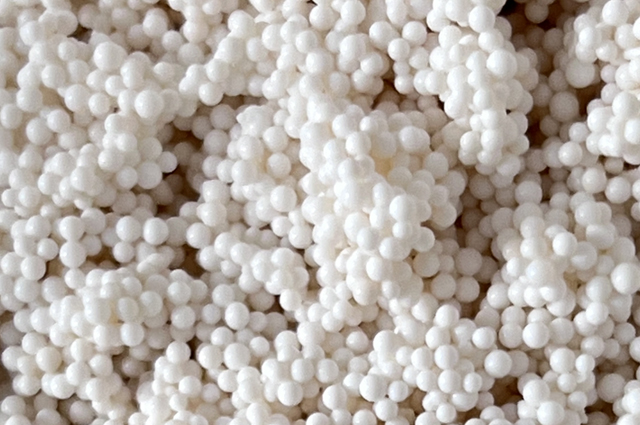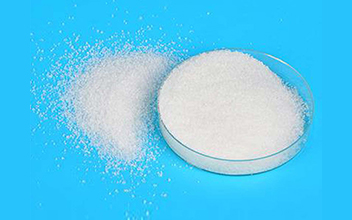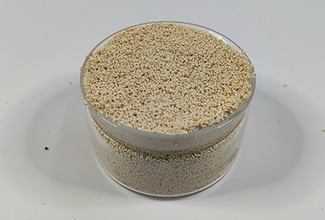Cation Exchange Resin VS Anion Exchange Resin
Introduction to Ion Exchange Resins
Ion exchange resins are made from highly porous polymeric materials that are resistant to acids and bases and insoluble in water. These resins are in the form of tiny beads, approximately 0.5 millimeters in diameter, and are typically derived from hydrocarbons. The core function of ion exchange resins is to separate, purify, and regulate the concentration of substances by exchanging them with ions in solution through active sites on their surface.
Cation Exchange Resin
Cation Exchange Resin is a special type of ion exchange resin in which the ions on its functional groups can only be exchanged with cations in water. This characteristic determines its unique role in chemical processes. For example, cation exchange resins often contain weakly acidic groups such as carboxyl groups (-COOH). In water, the carboxyl group dissociates H+, making the resin acidic. When the resin dissociates, the remaining negatively charged groups (e.g., R-COO-) are able to adsorb and bind other cations in solution, resulting in a cation exchange effect.
Classification of Cation Resins
Cation exchange resins can be classified into strong acid cation resins and weak acid cation resins according to their degree of ionization.
Strong Acid Cation Resin
Strong Acid Cation Resin is widely used in deionization and water softening processes. It maintains high ion exchange capacity over a wide pH range and is suitable for treating a wide range of water qualities. Due to its strong exchange capacity, regeneration with a strong acid is often required to restore its exchange activity. In industrial and domestic water treatment, strong acid cation resins are a common choice for removing calcium and magnesium ions from water and preventing scale formation.
Weakly Acidic Cation Resins
Weakly Acidic Cation Resins are primarily used to remove divalent ions associated with alkalinity. Weak Acid Cation Resins are well suited when the hardness to alkalinity ratio in water is 1:1 or higher. Weak acid cation resins have difficulty dissociating and exchanging ions at lower pH values than strong acid cation resins, and are better suited to work in alkaline, neutral or slightly acidic conditions. In some industries with specific water quality requirements, weakly acidic cation resins can accurately remove the target ions and ensure the stability of the production process.
Working Principle
The working principle of cation exchange resins is based on the reversible chemical reaction of their chemically active groups with cations in solution. When a solution containing cations passes through a column containing a cation exchange resin, the cations in the solution are exchanged with the active groups on the resin. For example, during water softening, calcium and magnesium ions (Ca2+, Mg2+) in the water are exchanged with sodium ions (Na+) on the resin, causing the calcium and magnesium ions in the water to be adsorbed on the resin and the sodium ions to be released into the water, which reduces the hardness of the water.
Anion Exchange Resins
Anion exchange resins are positively charged ion exchange resins that attract negatively charged ions (anions) in solution. This property makes anion exchange resins important in a variety of applications, especially in water treatment, biotechnology and chemical processing.
Principle of operation
The operation of anion exchange resins depends on the functional groups on their surface, commonly amine or quaternary ammonium groups. When anions in solution enter the stationary phase of the resin, these anions undergo an exchange reaction with the functional groups on the resin, while other anions are released from the resin, resulting in the adsorption or separation of the anions. For example, in water treatment, sulfate ions (SO42-) and nitrate ions (NO3-) in water can be exchanged with hydroxide ions (OH-) on the resin to remove these anions from the water.
Classification of Anion Resins
Anion exchange resins can likewise be classified into strong base anion resins and weak base anion resins.
Strong Base Anion Resins
Strong Base Anion Resins retain their positive charge over a wide pH range and are suitable for demineralization and dealkalization processes. In water treatment, it is often used to remove sulfate, nitrate and other anions from water, and is an important material for the preparation of high-purity water. Due to its stable positive charge characteristics, strong base anion resin can play a good role in various water quality conditions.
Weak Base Anion Resin
Weak Base Anion Resin is relatively weak in alkalinity and loses its charge at higher pH values. However, it performs well in removing acids and organic compounds from water, thanks to its high mechanical and chemical stability. Weak base anion resins are ideal in scenarios where trace amounts of acids or organic contaminants in water need to be removed.
Applications of Cation and Anion Exchange Resins
Applications of Cation Exchange Resins
Water Treatment
In the field of water treatment, cation exchange resins are often used in conjunction with anion exchange resins for the complete removal of cationic and anionic contaminants from water. This combination is particularly important in demineralization and dealkalization processes to produce high-quality water that meets a variety of industrial and domestic needs. For example, in the power industry, where high purity water is critical to the safe operation of boilers, cation exchange resins play a key role in removing metal ions from water and preventing boiler scaling.
Biotechnology
In bioprocessing, cation exchange chromatography is widely used to separate and purify biomolecules such as proteins and antibodies. Since different biomolecules have different charge characteristics, cation exchange resins can selectively adsorb and separate target biomolecules according to these charge differences, providing important technical support for biopharmaceutical and biological research.
Application of Anion Exchange Resins
Separation and Purification of Anionic Substances
Anion exchange resins achieve the separation and purification of anionic substances by combining anions in solution with exchange groups on the resin. This property is used in the chemical analysis and pharmaceutical industries to purify various compounds and to ensure the quality and purity of products.
Recovery of valuable anionic substances
Anion exchange resins are able to recover valuable anionic substances such as metal ions and rare earth ions from wastewater. This not only helps to recycle resources, but also reduces environmental pollution. In electronic waste treatment, anion exchange resins can effectively recover the precious metal ions therein and realize the reuse of resources.
Adjustment of solution anion concentration
By exchanging with anionic substances in solution, anion exchange resin can adjust the anion concentration of solution. For example, in water quality treatment, anion exchange resin can be used to adjust the concentration of chlorine ions in water to meet the needs of different industrial production and domestic water.
Preparation of anionic solution
The anion exchange resin can also prepare an anionic solution by exchanging with a cationic substance in a solution. For example, through specific exchange reactions, chlorine-containing solutions can be prepared from anion exchange resins for use in areas such as disinfection and chemical synthesis.
Specific Application Scenarios
- Chemical Separation: In the process of chemical separation, anion exchange resins are often used to remove or separate positively charged anionic substances from a solution, realizing the purification and separation of compounds. ·
- Water treatment: In water treatment, anion exchange resin can remove anions such as nitrate and phosphate in water, prevent eutrophication of water body and protect water environment. ·
- Biochemistry: In biochemistry, anion exchange resins are commonly used in ion exchange chromatography, such as the separation and purification of proteins or nucleic acids, providing an important tool for life science research.
Conclusion
Cation exchange resins and anion exchange resins differ significantly in their chemistry, working principles, types and applications.
In terms of application, cation exchange resins play an important role in the field of water treatment and biotechnology, while anion exchange resins are widely used in the separation and recovery of anionic substances and solution conditioning.
The correct choice of cation exchange resins or anion exchange resins depends on the specific application requirements and solution characteristics. By gaining a deeper understanding of the properties of both types of resins, their advantages can be more effectively utilized for the optimization of a variety of industrial and scientific processes. Ion exchange resins will continue to play an irreplaceable role in improving water quality, recovering resources and advancing biotechnology.
-
 Anion Exchange Resin Gold Extraction ResinAppearance:Milky white opaque spherical particleIon form:Cl-Volume complete exchange capacity(eql/L):≥1.35
Anion Exchange Resin Gold Extraction ResinAppearance:Milky white opaque spherical particleIon form:Cl-Volume complete exchange capacity(eql/L):≥1.35 -
 High Water Absorbent Resin for Diapers Super Absorbent PolymerNontoxic, harmless, nonpollutingHigh water absorbent capacityRaw material
High Water Absorbent Resin for Diapers Super Absorbent PolymerNontoxic, harmless, nonpollutingHigh water absorbent capacityRaw material -
 Chelating Resin for Precious Metals RecoveryAppearance: Milky to light yellow opacity spherical beadsIonic form:Na+Volume complete exchange capacity(mmol/ml):≥2.0
Chelating Resin for Precious Metals RecoveryAppearance: Milky to light yellow opacity spherical beadsIonic form:Na+Volume complete exchange capacity(mmol/ml):≥2.0

